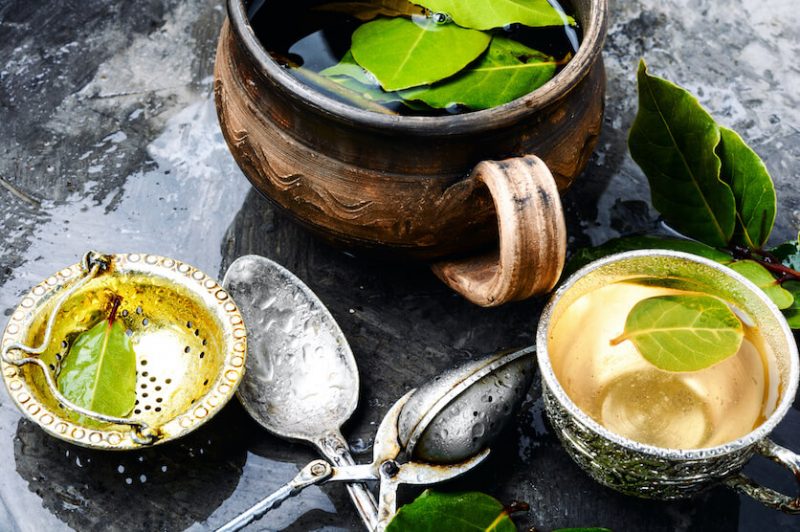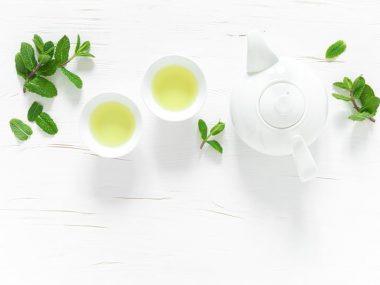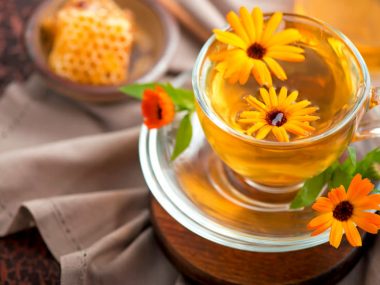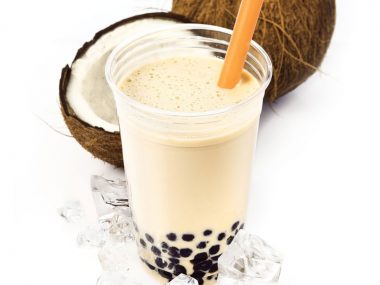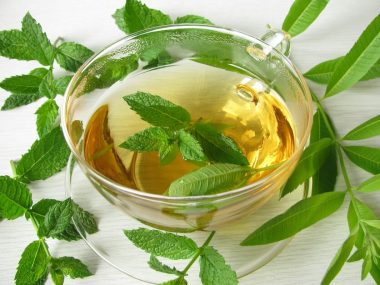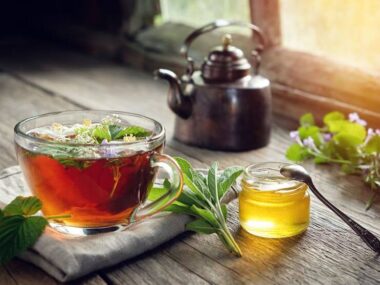A simple dried leaf in a spice jar may seem unassuming, but don’t let its dried-out character make you think it has little to offer. This lifeless leaf comes to life the minute it hits a pan of water or hot liquid, leaving you surprised how well bay leaf tea can taste!
Table of Contents
Can You Make Tea From Bay Leaves?
Yes, bay leaves can be used to make tea. This tea is known as a tisane (herbal tea) because it is not made from a true tea (black, green, oolong, yellow, white.) Most people who drink bay leaf tea do so for the potential health benefits it offers.
What Is Bay?
Bay is a large shrub (Laurus nobilis) that is native to the Mediterranean region. The leaves of this shrub are plucked and used in traditional medicine to treat various ailments and conditions. These leaves are also used to not only flavor certain dishes while cooking but also to make a tisane (herbal tea.)
The spice and flavoring industry cultivates and harvests bay leaves which go on to be sold in stores. One of the most common uses of bay leaf is to flavor heavy, soupy dishes such as stews and soups. Bay infuses a dash of subtle mintiness to help lighten the overall flavor.
Bay is known as sweet bay, true bay, and Turkish bay. There are three loosely used references for bay leaves that can be misleading when it comes to selecting bay leaves for tea or cooking. Turkish bay leaf, California bay leaf, and simply “bay leaf” often come up in recipes for dishes or teas. So, which bay leaf is the one to use for tea? Turkish bay (Laurus nobilis) is the bay leaf we use for cooking and making tea.
California bay (Umbellularia california) is known as “Oregon myrtle.” It is referenced as an ingredient in some recipes; however, this bay leaf should not be used to make tea as it produces a very unpleasant cup of tea. Many people unknowingly purchase this “pseudo” bay for tea only to find it’s the wrong type of bay. Furthermore, the taste is highly pungent and bitter.
The History Behind Bay
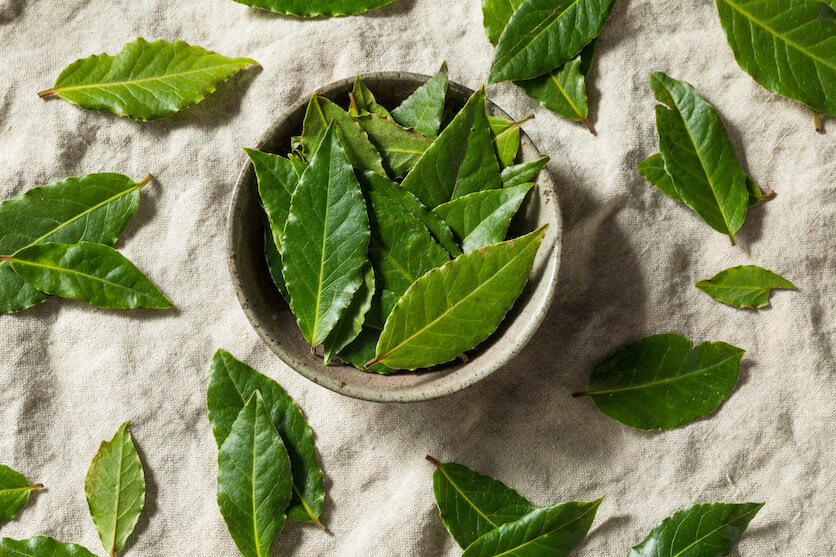
The bay leaf has a rich historical background. This simple green leaf was a symbol of achievement in the form of a crown in ancient Greece. This leafy crown was the coveted prize competitors strived for in the Olympics. There were no fancy medals as there are today but rather the crown of bay leaves.
Ancient rulers such as Julius Caesar wore crowns of bay laurel leaves as a symbol of nobility (hence its scientific epithet, “nobilis.”). The Greek god Apollo also wore this round crown of bay leaves. The laurel (bay) crown has since been a symbol of nobility, and achievement and although it’s no longer worn as a crown, you’ll find this symbol engraved on diplomas. The esteemed highest recognition of accomplishment and achievement is known as the Nobel Prize. Recipients of the Nobel Prize are known as “Nobel Laureates.” A “laureate” is someone who is awarded a laurel (bay) wreath.
Those living in the Mediterranean in ancient times were said to have regarded bay bushes as powerfully protective plants. They often planted bay bushes near their houses to ward off lightning, poverty, and more. Oddly, Tiberius (an ancient Roman ruler) made sure to keep a bay leaf on his person to avoid being struck by lightning.
What Does Bay Leaf Tea Taste Like?
Most will say bay leaves offer little as far as a spice to foods, but that is because a dried bay leaf has little to no smell. The magic happens when the dried leaf is dropped into a liquid-based dish while cooking. The bay leaf infuses a slightly bitter bite with a minty, piney flavor to the dish. Often this minty taste is compared to that of a fresh-cut balsam fir tree.
When making tea with bay leaves, you’ll find there are many more dimensions of flavors that come through. Tea drinkers have experienced layers of flavors that begin with a sharp pungent pine followed by peppery hints that taste similar to thyme, coriander, cloves, or oregano and a finish of minty eucalyptus menthol. The complexity of these odd flavors is intriguing to the palate.
How Much Caffeine Is In Bay Leaf Tea?
Bay leaf tea is a tisane (herbal tea). Tisanes do not contain caffeine unless a true tea (black, green, oolong, yellow or white) is part of the ingredients. Many tea drinkers choose tisanes to enjoy because they are caffeine-free. To give you an idea of caffeine comparison, tisanes are zero caffeine, whereas a six-ounce cup of black or green tea can have as much as 50 mg of caffeine.
Does Bay Leaf Tea Help You Sleep?
Several studies indicate essential oil of bay (in certain doses) as having an anticonvulsant benefit by slowing down the central nervous system. One research study (Laurus nobilis: Composition of Essential Oil and Its Biological Activities) notes that linalool (a compound in bay essential oil) has a sedative effect on the central nervous system. Thus bay leaf may have this soothing effect on you.
In Iran, traditional medicine searching for a remedy for seizures became the focus of a research study (Anticonvulsant activity of the leaf essential oil of Laurus nobilis against pentylenetetrazole- and maximal electroshock-induced seizures.) Using mice, scientists narrowed down compounds responsible for potentially having a sedative effect. They stated further research is warranted before any conclusive results can be confirmed.
Is Bay Leaf Tea Good For You?
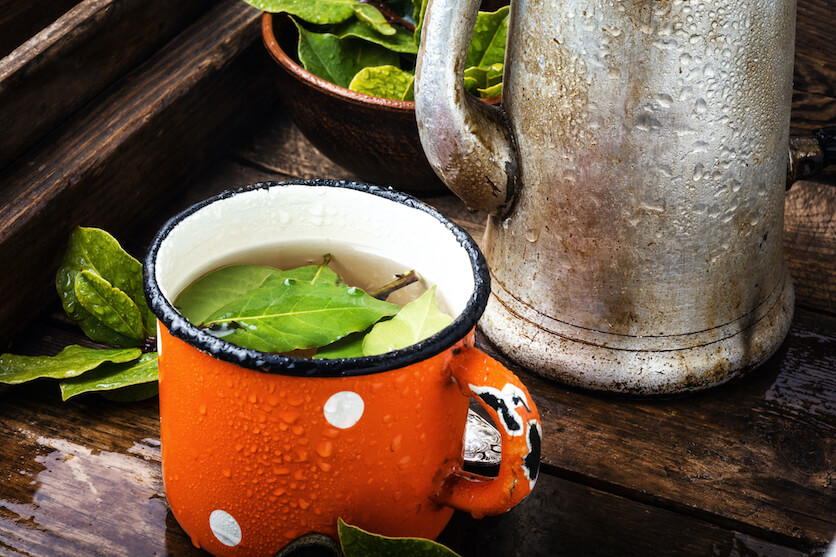
Because most tisanes (herbal tea) are made from plants, tea drinkers may not be aware of any potential dangers that hide in that cup of tea. Some herbs/plants can interact with certain medications, cause adverse reactions, have side effects, or worsen certain medical conditions.
It’s important to consult with your healthcare provider before consuming any tea (tisanes and true teas.)
There’s insufficient research on the safety of bay leaf tea. A study does state a whole bay leaf cannot be digested, and it continues to remain intact as it travels through the digestive system. They also mention bay leaf having possible interference with blood sugar, making it potentially unsafe for people with diabetes. The study cautions to stop consumption of bay leaf two weeks before surgery due to possible interaction with anesthesia causing the depression of the central nervous system. Furthermore, bay leaf needs further research before being considered safe for pregnant or nursing women.
Is It Okay To Drink Bay Leaf Tea Every Day?
We don’t have the medical expertise to provide advice or recommendations on the safety of consuming bay leaf tea. What we can do is provide you with evidence-based information from various research studies to help you determine if you should or should not enjoy this tea.
Does Bay Leaf Tea Lower Blood Pressure?
Finding supporting data on bay leaf lowering blood pressure yielded no results. We managed to find a study (Effect of Bay Leaves Boiled Water on Reducing Blood Pressure in Hypertension Patients at Sidorejo Public Health Center (PHC) in Lubuklinggau) that found no significant decrease in blood pressure after drinking bay leaf tea.
Does Bay Leaf Tea Lower Cholesterol?
A study (Bay Leaves Improve Glucose and Lipid Profile of People with Type 2 Diabetes) found that a significant decrease in LDL cholesterol of 32-40% was exhibited in people with diabetes. Further studies are required to substantiate the findings.
Bay Leaf Tea Side Effects
There are claims that bay leaf may cause sedation. However, the only evidence-based data connecting bay leaf and sedation were through the studies we mentioned above (“Does Bay Leaf Tea Help You Sleep?”). The study states sedation occurs at certain doses, but those doses are not mentioned.
Bay Leaf Tea Benefits
The “Medicinal Plants of Southeast Asia” published an article on the beneficial pharmacological uses of the bay. The report noted bay’s sesquiterpene lactones which inhibit inflammation. Based on this statement, bay is said to be anti-inflammatory. It goes on to state compounds in the bay essential oil as having the analgesic ability and antioxidant activity—traditional use of bay targets inflammatory conditions, pain, indigestion, diabetes, and other ailments. The article confirms bay’s effectiveness as antifungal, antiviral, and antibacterial.
Rutgers University’s Department of Food Science and Center for Advanced Food Technology published a research study identifying a compound in bay (sesquiterpene lactones) as having anti-inflammatory properties.
How To Make Bay Leaf Tea
Making bay leaf tea is relatively straightforward.
Bay Leaf Tea Recipe
Ingredients
- 2 cups of water
- 3-4 whole Turkish bay leaves
Directions
- Bring the water to a boil.
- Remove from the heat.
- Drop the bay leaves into the hot water and allow them to steep for 5 minutes.
- Remove the bay leaves.
- Pour the tea into a teacup.
- Add milk, sugar, or honey as desired.
- Enjoy!
Bay May Have Something1
Bay appears to potentially have benefits when enjoyed as a tea. Exploring this spice, along with many others, makes your tea journey all the more interesting.
